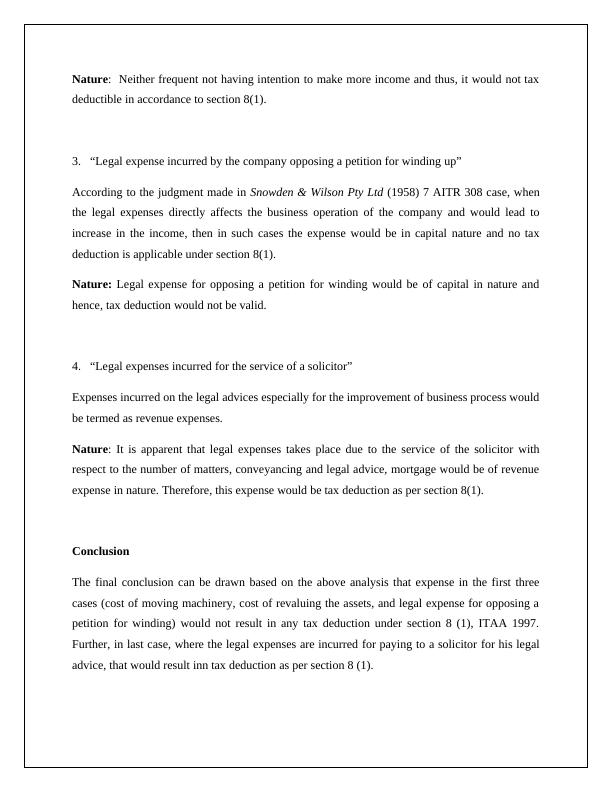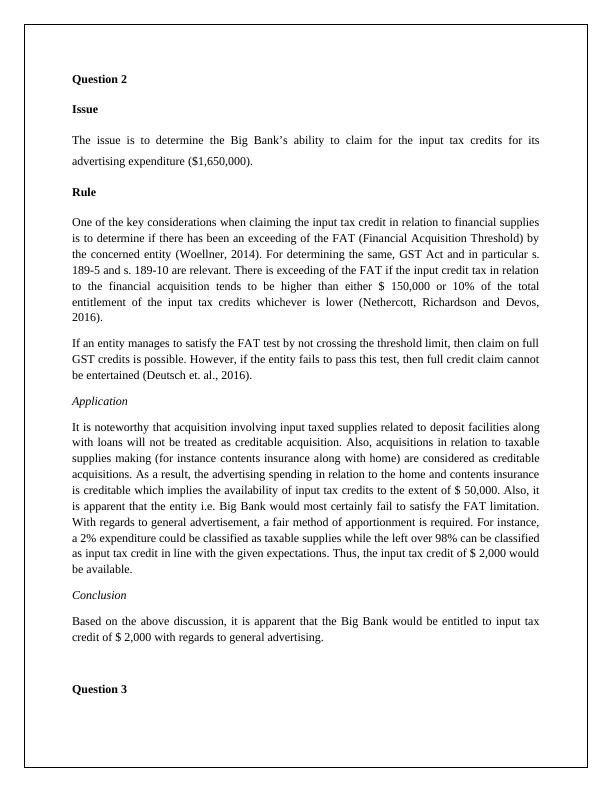HI3042 - Assignment On Taxation Law
Added on 2020-03-01
14 Pages1855 Words55 Views
Taxation LawHI3042[Pick the date]Student id

Question 1 Issue The issue is to comment whether the given losses or expenses are allowable as tax deductionunder the provisions of s 8-1 of ITAA 1997. Rule The provisions of section 8(1), ITAA 1997 would be taken into account in regards to find the taxdeduction on the losses or expenses incurred in business process to generate assessable income.The main factors are as listed below (Barkoczy, 2017).Losses would not be tax deductible if the “outgoing is of capital nature”Expenses or loss incurred in the process of deriving exempt income would not be taxdeductible (CCH, 2013). Expenses or loss incurred would not be tax deductible if the nature is domestic or personalnature (Gilders et. al., 2016). Application1.“Cost of moving machinery for a new site” Nature - outgoing is of capital nature and hence, would not tax deductible as per section 8(1),ITAA 1997. 2.“Cost of revaluing the assets to effect the insurance cover” Tax deduction in such cases would depend on the fact that whether the revaluing is beingconducted to enhance the income or not. This expense would lead to tax deduction only if therevaluing of assets takes place to derive more income. On the other hand, when the revaluing ofasset is not frequent and conducted with the intention to preserve or protect the respective assetthen the expense would not be tax deductible.

Nature: Neither frequent not having intention to make more income and thus, it would not taxdeductible in accordance to section 8(1). 3.“Legal expense incurred by the company opposing a petition for winding up”According to the judgment made in Snowden & Wilson Pty Ltd (1958) 7 AITR 308 case, whenthe legal expenses directly affects the business operation of the company and would lead toincrease in the income, then in such cases the expense would be in capital nature and no taxdeduction is applicable under section 8(1). Nature: Legal expense for opposing a petition for winding would be of capital in nature andhence, tax deduction would not be valid. 4.“Legal expenses incurred for the service of a solicitor” Expenses incurred on the legal advices especially for the improvement of business process wouldbe termed as revenue expenses. Nature: It is apparent that legal expenses takes place due to the service of the solicitor withrespect to the number of matters, conveyancing and legal advice, mortgage would be of revenueexpense in nature. Therefore, this expense would be tax deduction as per section 8(1). Conclusion The final conclusion can be drawn based on the above analysis that expense in the first threecases (cost of moving machinery, cost of revaluing the assets, and legal expense for opposing apetition for winding) would not result in any tax deduction under section 8 (1), ITAA 1997.Further, in last case, where the legal expenses are incurred for paying to a solicitor for his legaladvice, that would result inn tax deduction as per section 8 (1).

Question 2 IssueThe issue is to determine the Big Bank’s ability to claim for the input tax credits for itsadvertising expenditure ($1,650,000). Rule One of the key considerations when claiming the input tax credit in relation to financial suppliesis to determine if there has been an exceeding of the FAT (Financial Acquisition Threshold) bythe concerned entity (Woellner, 2014). For determining the same, GST Act and in particular s.189-5 and s. 189-10 are relevant. There is exceeding of the FAT if the input credit tax in relationto the financial acquisition tends to be higher than either $ 150,000 or 10% of the totalentitlement of the input tax credits whichever is lower (Nethercott, Richardson and Devos,2016).If an entity manages to satisfy the FAT test by not crossing the threshold limit, then claim on fullGST credits is possible. However, if the entity fails to pass this test, then full credit claim cannotbe entertained (Deutsch et. al., 2016).ApplicationIt is noteworthy that acquisition involving input taxed supplies related to deposit facilities alongwith loans will not be treated as creditable acquisition. Also, acquisitions in relation to taxablesupplies making (for instance contents insurance along with home) are considered as creditableacquisitions. As a result, the advertising spending in relation to the home and contents insuranceis creditable which implies the availability of input tax credits to the extent of $ 50,000. Also, itis apparent that the entity i.e. Big Bank would most certainly fail to satisfy the FAT limitation.With regards to general advertisement, a fair method of apportionment is required. For instance,a 2% expenditure could be classified as taxable supplies while the left over 98% can be classifiedas input tax credit in line with the given expectations. Thus, the input tax credit of $ 2,000 wouldbe available.ConclusionBased on the above discussion, it is apparent that the Big Bank would be entitled to input taxcredit of $ 2,000 with regards to general advertising.Question 3

End of preview
Want to access all the pages? Upload your documents or become a member.
Related Documents
HI3042 Taxation Law T2 2017 Assignmentlg...
|14
|1682
|53
Principles of Taxation- Assignmentlg...
|6
|949
|70
HI3042- Taxation Law Assignmentlg...
|10
|1743
|33
HA3042 Assessment 2 Australian taxation law TABLE OF CONTENTSlg...
|10
|1522
|91
HI3042 Taxation Law T2 2017 INDIVIDUAL ASSIGNMENT STUDENT ID AND NAMElg...
|7
|1388
|476
Expenditures and Losses Underlying the Businesslg...
|8
|2595
|436
